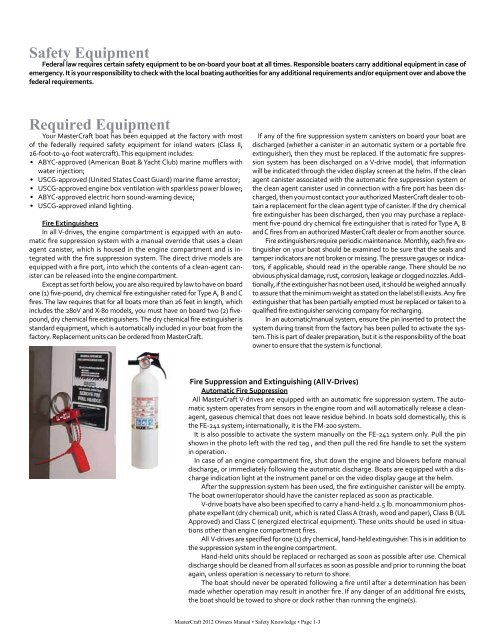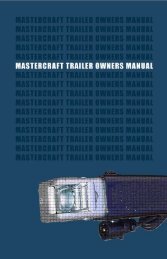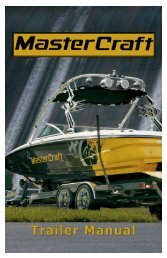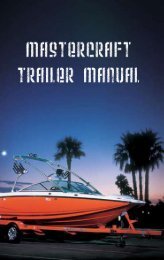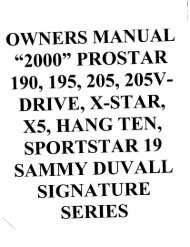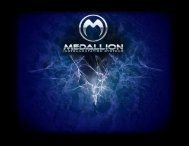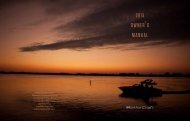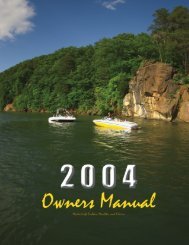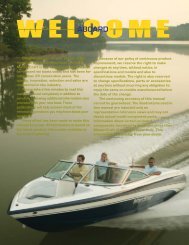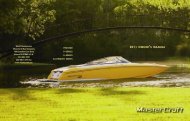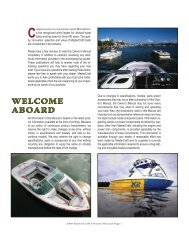2012 MasterCraft Owners Manual
2012 MasterCraft Owners Manual
2012 MasterCraft Owners Manual
Create successful ePaper yourself
Turn your PDF publications into a flip-book with our unique Google optimized e-Paper software.
Safety Equipment<br />
Federal law requires certain safety equipment to be on-board your boat at all times. Responsible boaters carry additional equipment in case of<br />
emergency. It is your responsibility to check with the local boating authorities for any additional requirements and/or equipment over and above the<br />
federal requirements.<br />
Required Equipment<br />
Your <strong>MasterCraft</strong> boat has been equipped at the factory with most<br />
of the federally required safety equipment for inland waters (Class II,<br />
26-foot-to-40-foot watercraft). This equipment includes:<br />
• ABYC-approved (American Boat & Yacht Club) marine mufflers with<br />
water injection;<br />
• USCG-approved (United States Coast Guard) marine flame arrestor;<br />
• USCG-approved engine box ventilation with sparkless power blower;<br />
• ABYC-approved electric horn sound-warning device;<br />
• USCG-approved inland lighting.<br />
Fire Extinguishers<br />
In all V-drives, the engine compartment is equipped with an automatic<br />
fire suppression system with a manual override that uses a clean<br />
agent canister, which is housed in the engine compartment and is integrated<br />
with the fire suppression system. The direct drive models are<br />
equipped with a fire port, into which the contents of a clean-agent canister<br />
can be released into the engine compartment.<br />
Except as set forth below, you are also required by law to have on board<br />
one (1) five-pound, dry chemical fire extinguisher rated for Type A, B and C<br />
fires. The law requires that for all boats more than 26 feet in length, which<br />
includes the 280V and X-80 models, you must have on board two (2) fivepound,<br />
dry chemical fire extinguishers. The dry chemical fire extinguisher is<br />
standard equipment, which is automatically included in your boat from the<br />
factory. Replacement units can be ordered from <strong>MasterCraft</strong>.<br />
If any of the fire suppression system canisters on board your boat are<br />
discharged (whether a canister in an automatic system or a portable fire<br />
extinguisher), then they must be replaced. If the automatic fire suppression<br />
system has been discharged on a V-drive model, that information<br />
will be indicated through the video display screen at the helm. If the clean<br />
agent canister associated with the automatic fire suppression system or<br />
the clean agent canister used in connection with a fire port has been discharged,<br />
then you must contact your authorized <strong>MasterCraft</strong> dealer to obtain<br />
a replacement for the clean agent type of canister. If the dry chemical<br />
fire extinguisher has been discharged, then you may purchase a replacement<br />
five-pound dry chemical fire extinguisher that is rated for Type A, B<br />
and C fires from an authorized <strong>MasterCraft</strong> dealer or from another source.<br />
Fire extinguishers require periodic maintenance. Monthly, each fire extinguisher<br />
on your boat should be examined to be sure that the seals and<br />
tamper indicators are not broken or missing. The pressure gauges or indicators,<br />
if applicable, should read in the operable range. There should be no<br />
obvious physical damage, rust, corrosion, leakage or clogged nozzles. Additionally,<br />
if the extinguisher has not been used, it should be weighed annually<br />
to assure that the minimum weight as stated on the label still exists. Any fire<br />
extinguisher that has been partially emptied must be replaced or taken to a<br />
qualified fire extinguisher servicing company for recharging.<br />
In an automatic/manual system, ensure the pin inserted to protect the<br />
system during transit from the factory has been pulled to activate the system.<br />
This is part of dealer preparation, but it is the responsibility of the boat<br />
owner to ensure that the system is functional.<br />
Fire Suppression and Extinguishing (All V-Drives)<br />
Automatic Fire Suppression<br />
All <strong>MasterCraft</strong> V-drives are equipped with an automatic fire suppression system. The automatic<br />
system operates from sensors in the engine room and will automatically release a cleanagent,<br />
gaseous chemical that does not leave residue behind. In boats sold domestically, this is<br />
the FE-241 system; internationally, it is the FM-200 system.<br />
It is also possible to activate the system manually on the FE-241 system only. Pull the pin<br />
shown in the photo left with the red tag , and then pull the red fire handle to set the system<br />
in operation.<br />
In case of an engine compartment fire, shut down the engine and blowers before manual<br />
discharge, or immediately following the automatic discharge. Boats are equipped with a discharge<br />
indication light at the instrument panel or on the video display gauge at the helm.<br />
After the suppression system has been used, the fire extinguisher canister will be empty.<br />
The boat owner/operator should have the canister replaced as soon as practicable.<br />
V-drive boats have also been specified to carry a hand-held 2.5 lb. monoammonium phosphate<br />
expellant (dry chemical) unit, which is rated Class A (trash, wood and paper), Class B (UL<br />
Approved) and Class C (energized electrical equipment). These units should be used in situations<br />
other than engine compartment fires.<br />
All V-drives are specified for one (1) dry chemical, hand-held extinguisher. This is in addition to<br />
the suppression system in the engine compartment.<br />
Hand-held units should be replaced or recharged as soon as possible after use. Chemical<br />
discharge should be cleaned from all surfaces as soon as possible and prior to running the boat<br />
again, unless operation is necessary to return to shore.<br />
The boat should never be operated following a fire until after a determination has been<br />
made whether operation may result in another fire. If any danger of an additional fire exists,<br />
the boat should be towed to shore or dock rather than running the engine(s).<br />
<strong>MasterCraft</strong> <strong>2012</strong> <strong>Owners</strong> <strong>Manual</strong> • Safety Knowledge • Page 1-3


